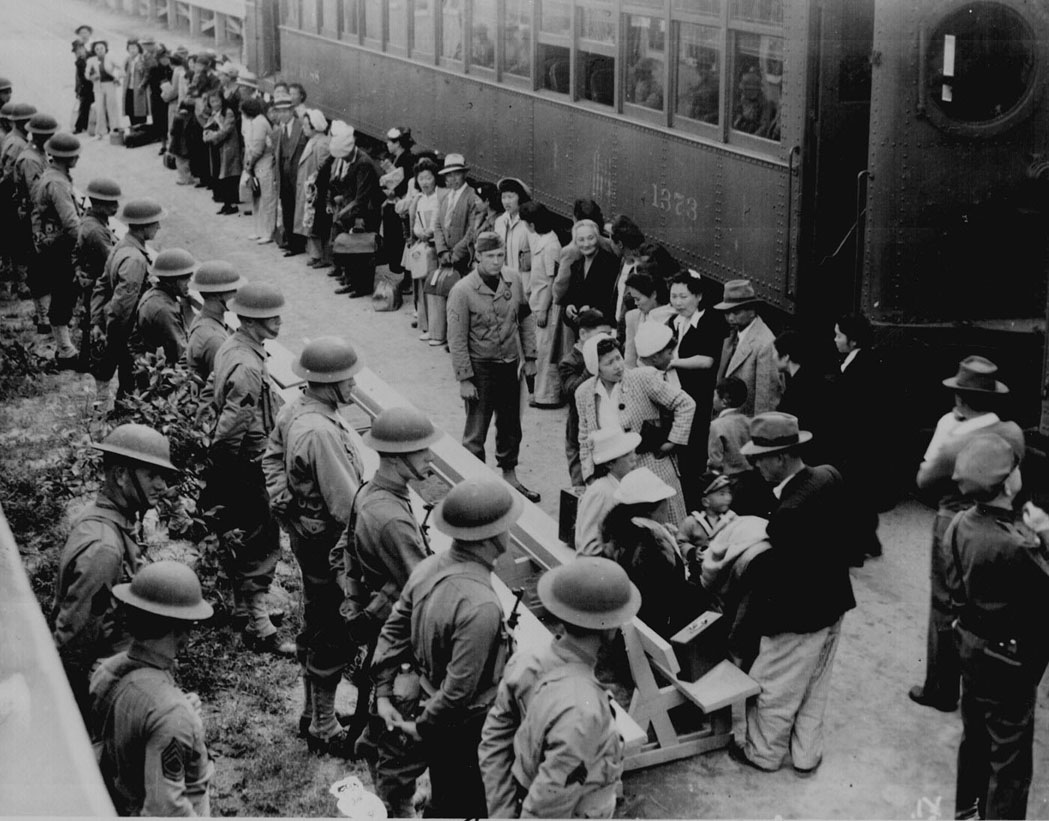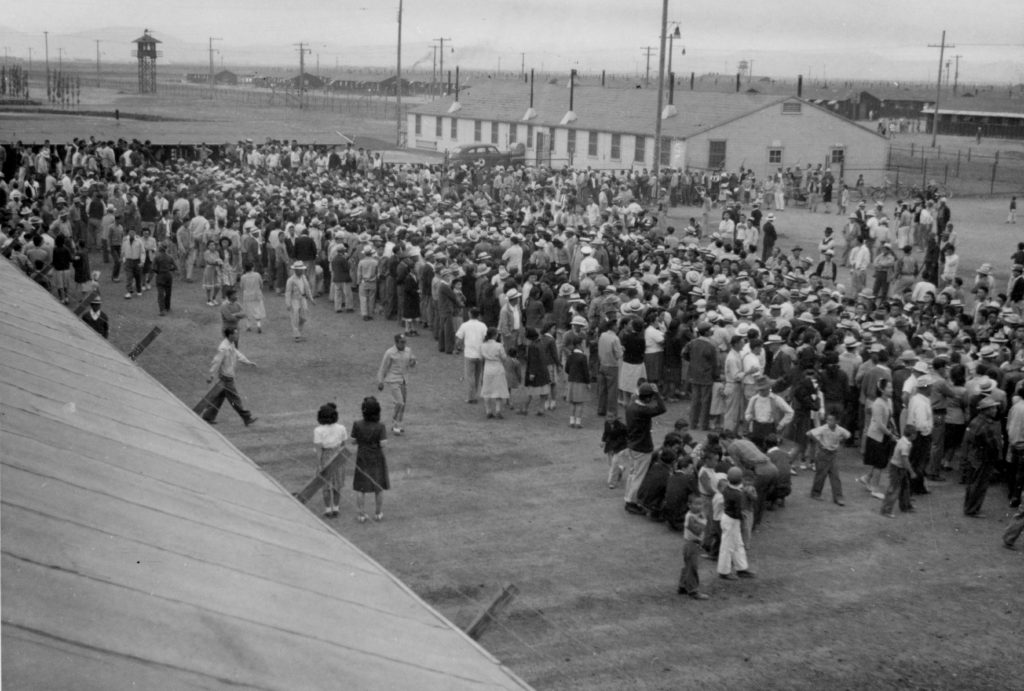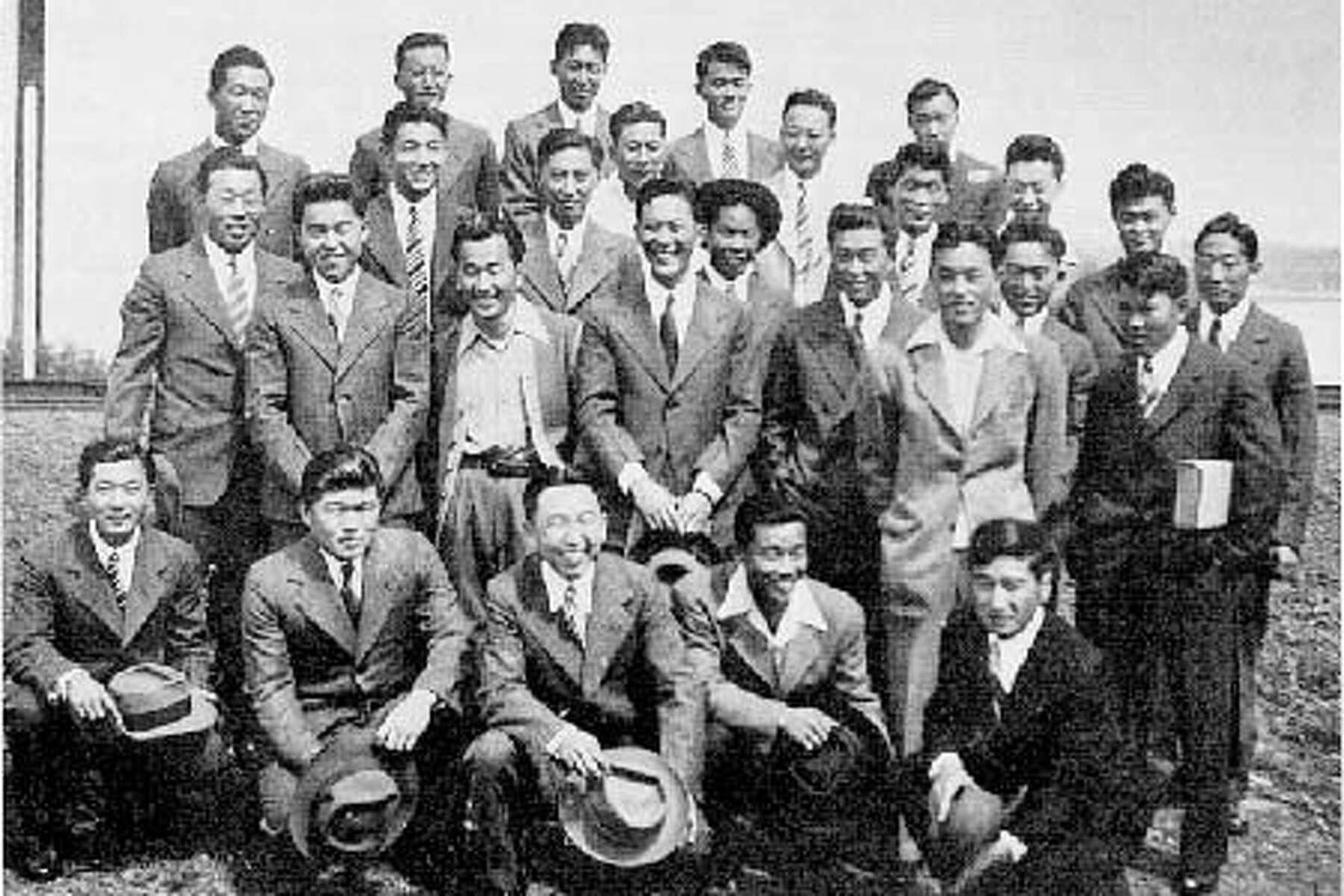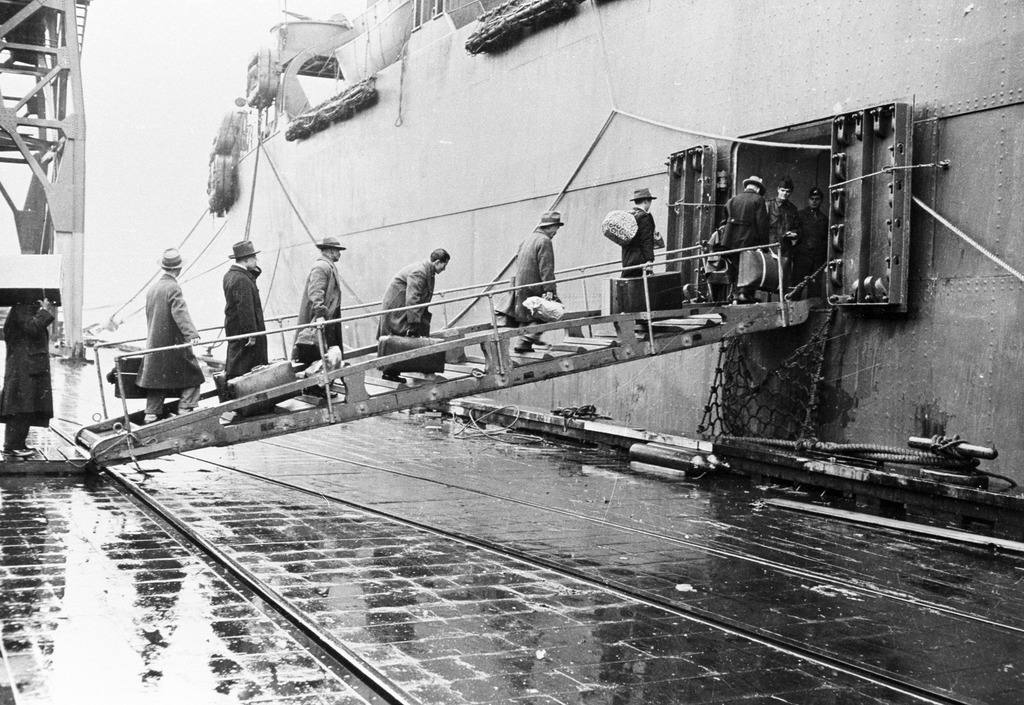| Race in America:
Nisei Resistance
By Mike Bennighof, Ph.D.
July 2022
 The “Go For Broke” story is one of heroism and sacrifice, from Japanese-American men who volunteered to fight for a government and society that scorned them and sent their families to concentration camps for their heritage.. The “Go For Broke” story is one of heroism and sacrifice, from Japanese-American men who volunteered to fight for a government and society that scorned them and sent their families to concentration camps for their heritage..
It’s not, however, the full story.
Executive Order 9066, signed by President Franklin D. Roosevelt in February 1942, classified Japanese-Americans (Nikkei) of draft age as “enemy aliens.” About 120,000 U.S. citizens, most of them from California, Oregon and Washington, were jammed into concentration camps; another 2,200 people of Japanese descent were shipped to the United States from Latin American countries (chiefly Peru) to join them.
As enemy aliens, Japanese-Americans were ineligible for the military draft, but in January 1943 Roosevelt issued another order allowing them to volunteer for Army service (they could not volunteer for the Navy, Air Corps or Marines). Thousands of Hawaiian Nisei flocked to enlist in the new 442nd Infantry Regiment; those imprisoned by their own government proved considerably less enthusiastic.
By late 1943, even before American troops had entered full-scale combat against the Germans, the U.S. Army began to feel manpower shortages. The thousands of fit young men held across the Mountain West seemed an untapped pool of potential soldiers, but voluntary recruitment efforts failed to excite their patriotism. And so in December 1943, a further executive order removed the “enemy alien” tag and made these men eligible for the draft beginning in January 1944.

It could never happen here. American troops force American citizens onto trains headed for concentration camps. Santa Anita, California, April 1942.
Nikkei deportees had offered very little resistance to their relocation; culturally, they had absorbed a fatalistic outlook summed up as “it can’t be helped.” The Japanese-American Citizens’ League, founded in 1930 to advance Nikkei political and cultural interests, counseled acceptance and non-resistance. But the JACL mostly represented the Nikkei elite: doctors, lawyers and academics already well-assimilated by dint of their professions. Or at least assumed themselves to be so. Resisting deportation meant accepting their Japanese identity, and thereby throwing away all the gains they had made toward becoming Americans.
“We are going into exile as our duty to our country,” JACL President Saboru Kido said in a March 1942 speech. “What greater love, what greater testimony of one’s loyalty could any one ask than this, leave your homes, your business, and your friends in order that your country may better fight a war?”
Having been forced to abandon their property, or sell it off for a sliver of its value, the internees – about 60 percent of whom were American citizens – were then forced to work in war-oriented light industries within the camps or in agriculture, at prison wages (typically $8 per month, at a time when unskilled farm laborers could count on fifty cents an hour). The camps themselves were hastily-erected, lacking basic necessities like showers and latrines, or converted warehouses and stables.
In November 1942, the JACL convened a national meeting in Salt Lake City, having chosen the delegates for their pro-American sentiments and secured special passes allowing those who’d been imprisoned to travel from their concentration camps. National Secretary Mike Masaoka – a Salt Lake City resident who was not himself sent to a concentration camp – pressed the delegates to accept a resolution calling on the Roosevelt administration to restore Japanese-American responsibilities under the Selective Service Act – that is, to be drafted into the American military. This, Masaoka argued, would prove their loyalty to the United States. The delegates, despite having been hand-picked by Masaoka, balked at what they believed would be a step so unpopular as to destroy the JACL’s legitimacy, eventually compromising on a call to allow their young men to volunteer for military service.
Army Chief of Staff George C. Marshall formally authorized the 442nd Infantry Regiment on 1 January 1943, and the War Department began accepting those volunteers in February 1943. Teams of officers started visiting the camps to register potential volunteers – as opposed to actual registration for the draft – with a lengthy questionnaire that infuriated most Nikkei. The Army estimated that the camps held about 10,000 eligible young men, and hoped to find 2,600 volunteers. Less than half that number responded, with Masaoka offering himself as the very first volunteer (Masaoka became the unit’s publicist, and is responsible for much of its fame). In contrast, 28 percent of all camp inmates refused to forswear allegiance to the Emperor of Japan as a calculated protest against the entire registration process.

They don't look like rioters. Inmates protest at Tule Lake, November 1943.
At the Heart Mountain concentration camp in Wyoming, of 1,700 eligible young men, 42 volunteered for the 442nd and almost five times as many refused to forswear the Emperor, while 329 Nisei and 151 Issei requested expatriation or repatriation, respectively, to Japan. At the Tule Lake concentration camp in California, the largest of the camps, very few inmates answered the questionnaire at all even as American soldiers ordered them to do so at bayonet point. Of those who did respond, almost all were classed as No-No’s after answering “no” to both key loyalty questions. Over 100 answered “fuck you” instead and went to local jails, despite the threat of 20 years in prison and a $10,000 fine. Fifty-seven men from Tule Lake volunteered for the 442nd.
While the 442nd’s war record would become iconic among Japanese-Americans after the war, at the time many camp inmates saw its segregated nature as further proof of their own country’s scorn for them. The War Department had already foreseen conscription as a necessary follow-on to the volunteer effort, in order to provide trained replacements for the regiment.
Within the War Department, conscription also opened the possibility that more men would be drafted than the 442nd could absorb. Would Japanese-Americans be integrated into other, white Army units, or would further segregated units have to be established for them? That solution implied a complicated logistical and administrative burden, but Maj. Gen. Allen Gullion, the Provost Marshal and a prime proponent of the internment of Japanese-Americans, argued that Black Americans would object to their own young men serving in segregated units while Japanese-Americans served alongside white men. Gullion, who openly spouted his hatred for Roosevelt, Blacks and Jews (and cared nothing for Black opinion), won out. Japanese-Americans would remain segregated in Army service.
Meanwhile, protests at Tule Lake (deemed “riots” by the press) broke out in November 1943, sparked by a suspicion that the administrators planned to reduce food rations. Tule Lake had become the dumping ground for No-No’s from all 10 concentration camps, with about 12,000 of the 18,700 inmates (in a camp built for 15,000) or their family members having refused to declare their loyalty to their captors. The Army moved in tanks and troops, declaring martial law which lasted until mid-January. Within a week of the troops’ removal, young Nikkei men began receiving draft notices.
Tule Lake of course showed the most resistance, with young men simply refusing to report. Those who did agree to do so were taken out of the camp to avoid further protests, but 27 draftees would be taken away to jail instead on charges of violating the Selective Service Act, and go on trial in July 1944. “It is shocking to the conscience,” U.S. District Judge Louis Goodman wrote, “that an American citizen be confined on the ground of disloyalty and then, while so under duress and restraint, be compelled to serve in the armed forces, or be prosecuted for not yielding to such compulsion.” Acquitted, the 27 young men were returned to the Tule Lake concentration camp.

Draft resisters from the Heart Mountain concentration camp (wearing government-issued suits) on the day of their release from McNeil Island Federal Penitentiary in Washington State. 14 July 1946.
At the Poston concentration camp in Arizona, 120 young men refused induction. The first 10 pleaded guilty in March 1944, and U.S. District Judge David Ling sentenced each to three years’ imprisonment. The next group of three pleaded guilty in April 1945, and Ling gave them one year each. Finally, 95 men pleaded guilty in October 1946, and Ling fined each man one cent.
At the Minidoka concentration camp in Idaho, draft compliance went quietly until Lt. B.M. Harrington, a white officer from Fort Douglas, Utah, decided to ad lib a brief speech before administering the oath to 66 young men.
“We in the American armed forces,” he began, “are happy to welcome you Japanese among our ranks, even though your country, Japan, is at war with the United States.”
One of the inductees – it’s not clear which – turned his back on Harrington, and walked out before the oath was administered. Soon the number of resisters at Minidoka had grown from two to 38. U.S. District Judge Chase A. Clark, the former governor of Idaho and an enthusiastic supporter of the concentration camps, ran what historian Eric L. Muller describes as a “kangaroo court.” The public defenders assigned to the accused (usually under duress themselves, as no attorney wished to be associated with the Japanese-Americans) usually called just one witness, the defendant.
Clark allowed the same pool of jurors to be used for all 33 cases that went to trial, meaning that some jurors heard a dozen or more cases. Juries met in the hallway outside the courtroom for a cigarette and a verdict – all 33 of them guilty, sentenced to 39 months in prison. Only one attorney contested the charges on Constitutional grounds, invoking Goodman’s ruling to cite that his client’s imprisonment placed him under coercion and duress (in violation of the Selective Service Act), which Clark swiftly dismissed. The Minidoka resisters were finally paroled in April 1947, and pardoned by President Harry S. Truman (along with all Nikkei draft resisters) on Christmas Eve 1947.
Altogether, 326 Nisei refused induction. Two of the ten camps appear to have had no resisters at all.

American citizens are deported to Japan. Seattle, Washington. 24 November 1945.
The Renunciation Act, signed by Roosevelt on 1 July 1944, allowed an American citizen to renounce their citizenship during wartime. The law had been designed to encourage Japanese-Americans held in concentration camps, particularly the No-No’s of Tule Lake, to give up their citizenship so that they could be deported to Japan. It worked: 5,589 Japanese-Americans renounced their U.S. citizenship, 5,461 of those from the Tule Lake concentration camp, where 70 percent of the U.S. citizens did so. Federal courts would later rule the renunciations void, as they occurred under duress. Nevertheless, at the end of the war 4,724 concentration camp inmates were deported to Japan, of whom 1,949 were U.S. citizens.
“They threw,” wrote Edward Ennis, the Justice Department official in charge of the concentration camps, “their citizenship back at us.”
The full series is here:
• Race in America: Founded on Slavery
• Race in America: Civil War
• Race in America: Jim Crow
• Race in America: The Black Doughboys, Part One
• Race in America: The Black Doughboys, Part Two
• Race in America: Red Summer
• Race in America: Tulsa
• Race in America: Klan Scam
• Race in America: Strange Fruit
• Race in America: Canada’s Shame
• Race in America: They Said No
Click right here to order Go For Broke (Third Edition) right now.
Please allow an extra three weeks for delivery.
Sign up for our newsletter right here. Your info will never be sold or transferred; we'll just use it to update you on new games and new offers.
Mike Bennighof is president of Avalanche Press and holds a doctorate in history from Emory University. A Fulbright Scholar and NASA Journalist in Space finalist, he has published an unknowable number of books, games and articles on historical subjects.
He lives in Birmingham, Alabama with his wife and three children. He misses his dog, Leopold.
Want to keep Daily Content free of third-party ads? You can send us some love (and cash) through this link right here. |
